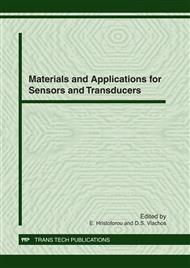p.37
p.41
p.45
p.49
p.53
p.58
p.62
p.67
p.71
Metrological Performances of Fiber Bragg Grating Sensors and Comparison with Electrical Strain Gauges
Abstract:
The fiber Bragg grating sensors (FBGs) have been recently introduced: they present a photorecord grating on the fiber itself, which allows the reflection of a certain wavelength of the input light spectrum. The applied strain is estimated relying on changes of the reflected wavelength. One of the possible applications that has prompted us to study this type of sensors is the possibility to create smart dynamometric structures based on carbon fiber by embedding FBGs. Many papers are available in literature about some applications with smart structures but there is not yet an appropriate metrological characterization about these FBG sensors, their strengths and weaknesses: for these reasons it was deemed useful making several tests on FBG sensors in terms of measurement accuracy, signal to noise ratio, ability to compensate for thermal effects and their behavior for dynamic applications. All these results have been compared to electrical strain gauge ones, which represent the actual reference strain measurement systems. The various solutions to compensate for thermal effects have offered several information for further analyses and the basis for a future use of these sensors for static or semi-static tests. Being fully aware of FBGs characteristics allows to draw down guidelines about their integration in composite materials for the most different applications, understanding in a better way the sensor response.
Info:
Periodical:
Pages:
53-57
Citation:
Online since:
November 2011
Price:
Сopyright:
© 2012 Trans Tech Publications Ltd. All Rights Reserved
Share:
Citation:


